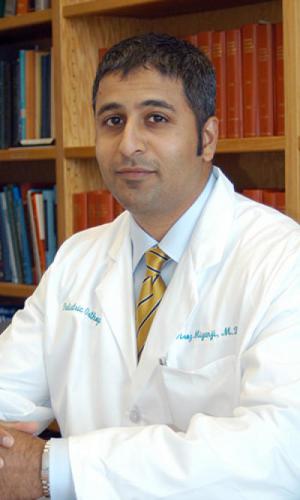Many kids with severe cerebral palsy (CP) will develop scoliosis, a sideways curvature of the spine that can cause chronic pain, mobility problems and other serious health issues. When they do, their families are faced with a difficult choice: Should their child undergo surgery on their spine? Often effective at correcting scoliosis, spinal fusion carries added risk for kids with severe CP, who are more likely to experiences serious complications from this operation.
New research by BC Children’s Hospital investigator and pediatric orthopedic surgeon Dr. Firoz Miyanji will help make that decision a little easier for families and their doctors and surgeons. The study, which was published in The Journal of Bone and Joint Surgery, shows scoliosis surgery improves the quality of life of children with severe CP even if they develop complications.
“As doctors, we know families place trust in our recommendations and we want to provide the best possible information when they’re facing a difficult decision like whether or not to put a child through major surgery," says Dr. Miyanji.
“We’re pleased that we’ll now be able to tell families that our research shows spinal surgery can reduce pain and improve mobility in this group of children who are already facing significant medical challenges.

Cerebral palsy is an umbrella term for disabilities affecting body movement, muscle tone and coordination that are caused by brain injury before, during or shortly after birth. It is the most common motor disability in childhood, affecting an estimated one in 500 babies. Twenty-five to 30 per cent of children with CP have a severe form of the condition that affects their entire body and requires them to use a wheelchair all or most of the time.
Due to the effects of CP on their spinal muscles, children with severe CP are particularly prone to developing scoliosis. Up to 35 per cent of children with severe CP will develop progressive scoliosis which cannot be controlled through non-surgical measures like a wearing a brace.
Spinal fusion surgery, in which the curved vertebrae are fused together so they heal as a single, solid bone, can stop the progression of scoliosis, make sitting more comfortable and reduce chronic pain and other health issues related to scoliosis. However, children with severe CP are at high risk for serious complications from this procedure, including pneumonia and surgical site infections. As a result, some doctors and researchers have become skeptical of the value of spinal fusion surgery for these medically complex children.
“Before this study, we had evidence about the medical outcomes of spinal fusion surgery, but we didn’t know how it impacted the day-to-day life of children and their caregivers,” says Dr. Miyanji. “This made it difficult for doctors and families to determine if surgery was really worth the risks.”
The study led by Dr. Miyanji included 69 children with severe CP who had spinal fusion surgery between 2008 and 2011 at seven hospitals across North America, including BC Children’s.
Researchers followed the children for five years. In addition to collecting data about the children’s surgical outcomes and complications, researchers asked their caregivers to complete questionnaires about their and their child’s everyday quality of life and before surgery and at one year, two years, and five years after surgery. The questionnaire covered areas including personal care, positioning, communication, comfort and emotions, and general health.
Ninety-two per cent of caregivers reported that their child’s quality of life was better one year after surgery. The questionnaires showed significant improvements in the areas of personal care, positioning and comfort across all the time periods studied.
Roughly half the children experienced complications in the five years after surgery. However, researchers found no correlation between surgical complications and quality of life scores.
This study confirms that spinal surgery should be the standard of care for children with severe CP who develop scoliosis that doesn’t respond to less invasive treatments. It also provides care providers with valuable information about how children and their families experience the outcomes of this surgery.
“We already knew that this surgery generally worked from a medical perspective, but we didn’t know if it was beneficial from the perspectives of patients and their families,” says Dr. Miyanji. “This is a great example of how research that focuses on a patient’s experiences can help us provide better care.”
This work was supported by the Setting Scoliosis Straight Foundation and BC Children’s Hospital Foundation.




